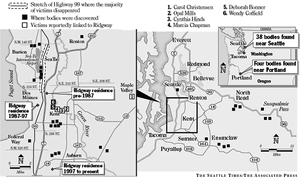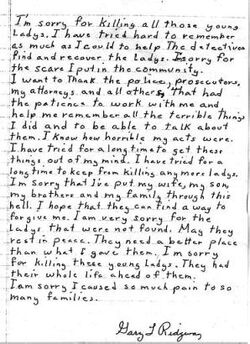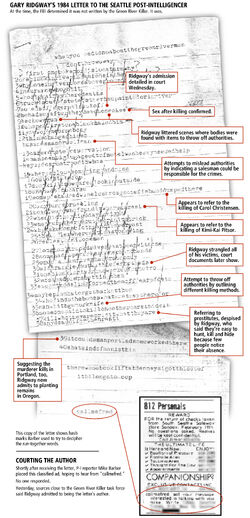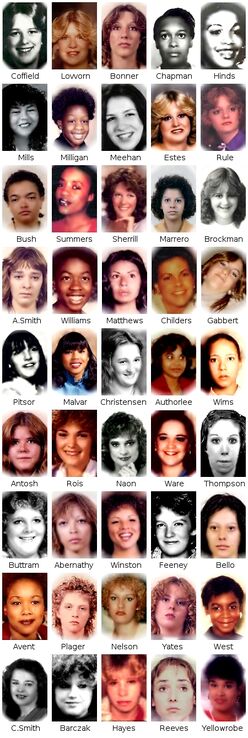| “ | I'm not a serial rapist, I'm a serial killer. | ” |
— Ridgway
| ||
Gary Leon Ridgway, a.k.a. "The Green River Killer" or "The Green River Strangler", is a necrophiliac and ephebophilic serial killer responsible for the murders of at least 49 women. He is considered one of the most prolific serial killers in US history.
Background
Ridgway was born in Salt Lake City, Utah on February 18, 1949, and raised in SeaTac, Washington. His father, Thomas Newton Ridgway, worked as a bus driver who often complained about the prostitutes who frequented the streets on his route. His mother, Mary Rita Ridgway (née Steinman), ruled the household and was physically and mentally abusive towards Gary and also to his two brothers, Gregory and Thomas Jr., and even her husband. Gary was a frequent bed-wetter and also tortured animals, locking a cat into a refrigerator until it died on one occasion. He would also shoot birds with a BB gun with his brothers. Having an estimated IQ of 82, he did poorly in school; he even had to redo a single school year twice before he could get passing grades. In 1963, aged 14, Gary attempted to kill a six-year-old boy by stabbing him, but was unsuccessful and was never caught for the act. He claimed to have committed his first murder when he was a teenager, drowning a young boy by wrapping his legs around him while swimming and holding him underwater until he drowned. At the age of 18, Gary enlisted with the Navy and served on board of a supply ship in Vietnam. Shortly after graduating high school and before being shipped off, he married a girlfriend named Claudia Barrows, but they divorced within only a year because both had extramarital affairs. Ridgway applied for a job as a police officer but failed. Instead, he found work as a car painter at a truck factory in Bellingham, Washington.
Ridgway married for the second time in December 1973, to one Marcia Winslow. Their union was also brief and ended for the same reason, though they conceived a son, Matthew, together. He was born in 1975 and maintained a relationship with his father, who was granted visitation rights after the divorce. Winslow later claimed that Gary once placed her in a choke-hold. During his second marriage, Ridgway became highly religious and spent a lot of time reading the Bible, sometimes aloud and at work, and was sometimes moved to tears by church sermons. He would also go door to door for his Pentecostal church. In a rather sharp contrast to this, he often solicited sexual favors from prostitutes and had a near-insatiable sex drive, demanding sex from his girlfriends and wives several times a day. Shortly after Winslow left him, he was arrested for trying to choke a prostitute near an airport. In April of 1982, he was also arrested for soliciting an undercover officer posing as a prostitute. Around 1985, Ridgway began dating one Judith Mawson and married her in 1988. They were still married at the time of his final arrest and shared a loving, intimate relationship; he stated in an interview that he felt less of an urge to kill while they were together, which would explain why he killed so few women after they started dating. In 1998, Thomas Ridgway passed away after a long struggle with Alzheimer's. Mary Ridgway died of cancer three years later.
Killings, Arrest, and Incarceration

View of the Green River near where several victims were found.

Maps denoting the locations of where Ridgway's victims were discovered.

Ridgway's court statement.
Ridgway committed his first confirmed serial murders in the 1980s, most of them in 1982 and 1983. He was brought in for questioning as a person of interest when the first bodies were found and took a polygraph test twice, once in 1982 and once in 1986, passing both times, and was a suspect during the entire investigation. He came close to being arrested a few times; in 1985, a woman accused him of grabbing her in a choke-hold in 1982, and in 1983, a witness saw victim Marie M. Malvar get into his car. In October of 1984, Ted Bundy, who was on death row in Florida at the time, contacted the Green River Task Force and offered his personal insights on the case and the area. He was interviewed a few times, though nothing useful came of it besides more confessions of his own murders. The police learned from several prostitutes in the Green River Killer's usual area that they had seen him driving on that strip, which was the route he took to get to work. It was also noted that he had been reported as absent from work on every single occasion that a victim had disappeared. In 1987, the police searched his house and took samples of his hair and saliva. Because there wasn't enough evidence to make an arrest, he was released. Ridgway's involvement in the investigation led his coworkers to nickname him "Green River Gary". As the years went by, more remains of his victims were found; the most recent finding was on December 21, 2010. In 1991, the Green River Task Force was reduced to a single person, Tom Jensen. For a decade afterwards, the case remained completely dormant. During that time, Ridgway is only confirmed to have committed a single murder.
It wasn't until 2001 that the big break in the case finally came when the murders were re-investigated with a task force consisting of 30 people, including forensic and DNA experts. A DNA comparison of semen found on the victims' bodies and the samples taken from Ridgway in 1987 was made using more recent technology and came back a match. Ridgway was consequently arrested, charged with the murders of Opal Mills, Marcia Chapman, Carol Christensen, and Cynthia Hinds; the first three were connected to him by DNA evidence and the fourth by circumstantial evidence. Three more charges, those of Wendy Coffield, Debra Bonner, and Debra Estes, were added when the investigators found traces of a kind of spray paint Ridgway used at work on their remains. In 2003, Ridgway made a plea bargain with the prosecution, agreeing to make a full confession and help the authorities find the remains of his victims in exchange for avoiding the death penalty. In total, he was convicted of 49 murders. He confessed to a total of 71, though some estimate that he may have killed more than 90 women. At one point during the legal proceedings when the victims' families gave testimonies, Ridgway broke into tears and told them he was sorry. As part of his plea bargain, the investigators began driving him between dump sites, where he would direct them to bodies which hadn't previously been found. He is currently serving his sentence at the Washington State Penitentiary in Walla Walla, Washington and is 69 years old.
Modus Operandi
"I would talk to her ... and get her mind off of the, uh, anything she was nervous about. And think, you know, she thinks, 'Oh, this guy cares,' and which I, I didn't. I just want to, uh, get her in the vehicle and eventually kill her."
Ridgway's victims were prostitutes, vagrants, or women he thought they were so. All of them were aged in their mid-teens to late thirties. He would pick them up, take them somewhere secluded, have sex with them, often from behind in order to get the drop on them, and then kill them by strangling them, usually with his arm, though he later started using various ligatures such as rope, fishing line, belts, extension cords, socks, or even T-shirts when he realized that the victims could potentially leave conspicuous defensive injuries on him. Some were killed in his home or in his truck. The bodies were then dumped in the wilderness, usually nude and sometimes posed. He had a habit of dumping them in "clusters" in different locations over a period of time, usually near some nearby landmark or in the water. He would return to the bodies to watch them decompose and change color and to engage in sexual acts with them. As a forensic counter-measure, he would scatter random trash around the crime scenes and carry some victims across the state line into Oregon to confuse the investigators.
Profile

Ridgway's 1984 letter to the Seattle Post-Intelligencer.
A behavioral profile of the Green River Killer was drafted in 1982 by John Douglas and his Investigative Support Unit. It was eventually revised in 1984, and, despite the fact that it indeed fitted some traits of Gary Ridgway, it was deemed to be too vague by members of the Green River task force, who never invested much hope in it. It is nonetheless worth noting it also presented several inconsistencies. The profile was never released to the public, though details from news articles and books on the case can be pieced together to get an idea:
The GRK was profiled as being a white male in his mid-twenties to early thirties, who is a shy and inadequate individual with low self-esteem and a strong sense of animosity towards women: "He (the killer) has felt that he has been 'burned' or 'lied to and fooled by women one too many times.' In his way of thinking, women are no good and cannot be trusted, and he feels women will prostitute themselves for whatever reason, and when he sees women openly prostituting themselves, this makes his blood boil". He would be a large man in good physical condition, capable of moving bodies from his vehicle to the river with relative ease. He is familiar with the sites where he disposed of his dead victims, and is an avid, conservative driver who owns a van or 4-door car, at least three years old and not well maintained. He would be of average to slightly higher intelligence, and is either unemployed or chronically underemployed: when he does work, his job requires more strength than skill.
He is a heavy beer drinker and smoker, and is divorced. He still sees prostitutes, with whom he also has non-violent encounters that end normally. He does not go out with the intention of killing someone, but rather his murders are "spur-of-the-moment" acts. He is not very neat or meticulous, and would be an outdoorsman, recreational fisherman, and hunter. He would also be interested in police work, and may have posed as a police officer or other authority figure to lure his victims. He is an angry individual who demonstrates power over his victims, and appears to have no racial preference. He enjoys the publicity he is receiving. Also, he does not "plan to put his victims through some sort of ritual sexual act or body positioning". His background would be of marital discord between his father and mother, and he was raised by a single parent. He did poorly at school and eventually dropped out. He would have a psychological history and/or records for crimes such as assault and rape. He would have strong religious feelings. Ultimately, profilers did not dismiss the possibility that two killers were actually involved.
Ridgway was thirty-three years old when the murders started, was described by some as being shy and having low self-esteem, had a strong animosity towards women and prostitutes in particular, was familiar with his sites of disposal, drove an old pick-up truck at the time, divorced twice, also had non-violent encounters with prostitutes, enjoyed hunting and fishing, applied to become a police officer, had a background of marital conflicts between his parents, was an underachiever at school, and had religious feelings. Despite this, he was not a large man, being small in stature and unassuming in appearance (though he was in a relatively good physical condition), drove in an erratic manner, was not unemployed or chronically underemployed, was not a heavy drinker, did not smoke, was described as a meticulous person, posed the body of at least one of his victims and inserted foreign objects in them, was not raised by a single parent, never dropped out of school (though he graduated late), had no prior records for violent crimes (only for prostitution charges), and he was revealed to be the sole perpetrator of the Green River Killings.
A letter Ridgway addressed to the Seattle Post-Intelligencer in early 1984 was erroneously thought by John Douglas to be the work of a publicity-seeker within the task force, due to the fact that it indeed contained details only the killer and the authorities could know. Douglas, who, in December 1983, while working on the case, was seized by stress-related viral encephalitis, later claimed he may have misinterpreted the letter due to his recovering from the illness, but added he didn't feel responsible for holding up the investigation since the communiqué was anonymous and the killer never wrote again after that.
Known Victims

Ridgway's identified victims.
Notes: Ridgway had confessed to a total of 71 murders, although authorities suspect he might be responsible for as many as over 90. A majority of the dates denote when the victims disappeared.
Confirmed
"I killed so many women I have a hard time keeping them straight."
- Unspecified date in 1963: Unnamed six-year-old boy (attempted, but survived; was stabbed)
- 1982:
- July 8: Wendy Lee Coffield, 16 (her body was found a week later)
- July 17: Gisele Ann Lovvorn, 17 (strangled with a men's sock; her body was found on September 25, 1982)
- July 25: Debra Lynn Bonner, 23 (her body was found on August 12, 1982)
- August 1: Marcia Fay Chapman, 31 (her body was found two weeks later)
- August 11: Cynthia Jean Hinds, 17 (her body was found four days later)
- August 12: Opal Charmaine Mills, 16 (strangled with a pair of blue pants; her body was found three days later)
- August 29: Terry Rene Milligan, 17 (her body was found on April 1, 1984)
- September 15: Mary Bridget Meehan, 18 (her body was found on November 13, 1983)
- September 20: Debra Lorraine Estes, 15 (her body was found on May 30, 1988)
- September 26: Linda Jane Rule, 16 (her body was found on January 31, 1983)
- October 8: Denise Darcel Bush, 23 (her body was found on June 12, 1985)
- October 9: Shawnda Leea Summers, 16 (her body was found on August 11, 1983)
- October 20-22: Shirley Marie Sherrill, 18 (her body was found on June 1985)
- November: Rebecca Garde, 20 (attempted; she escaped)
- December 3: Rebecca Marrero, 20 (her body was found on December 21, 2010)
- December 24:
- Colleen Renee Brockman, 15 (her body was found on May 26, 1984)
- Sandra Denise Major (her body was found on December 30, 1985)
- 1983:
- March 3: Alma Ann Smith, 18 (her body was found on April 2, 1984)
- March 8-14: Delores LaVerne Williams, 17 (her body was found on March 31, 1984)
- April 10: Gail Lynn Matthews, 23 (her body was found on September 18, 1983)
- April 14: Andrea M. Childers, 19 (her body was found on October 11, 1989)
- April 17:
- Sandra Kay Gabbert, 17 (her body was found on April 1, 1984)
- Kimi-Kai Pitsor, 16 (her body was found on December 15, 1983)
- April 30: Marie M. Malvar, 18 (her body was found on September 26, 2003)
- Prior to May: Wendy Stephens, 14 (her body was found on March 21, 1984)
- May 3: Carol Ann Christensen, 21 (strangled with a cord; her body was found five days later)
- May 22: Martina Theresa Authorlee, 18 (her body was found on November 14, 1984)
- May 23: Cheryl Lee Wims, 18 (her body was found on March 22, 1984)
- May 31: Yvonne "Shelly" Antosh, 19 (her body was found on October 15, 1983)
- May 31-June 13: Carrie Ann Rois, 15 (her body was found on March 10, 1985)
- June 8: Constance Elizabeth Naon, 19 (her body was found on October 27, 1983)
- July 18: Kelly Marie Ware, 22 (her body was found on October 29, 1983)
- July 25: Tina Marie Thompson, 21 (her body was found on April 20, 1984)
- August 18: April Dawn Buttram, 16 (her body was found on August 30, 2003)
- September 5: Debbie May Abernathy, 26 (her body was found on March 31, 1984)
- September 12: Tracy Ann Winston, 19 (her body was found on March 27, 1986)
- September 28: Maureen Sue Feeney, 19 (her body was found on May 2, 1986)
- October 11: Mary Sue Bello, 25 (her body was found on October 12, 1984)
- October 26: Pammy Annette Avent, 15 (her body was found on August 26, 2003)
- October 30: Delise Louise Plager, 22 (her body was found on February 14, 1984)
- Late October-Early November: "Marisa" (pseudonym; attempted; she escaped)
- November 1: Kimberly L. Nelson, 21 (her body was found on June 14, 1986)
- December 23: Lisa Lorraine Yates, 19 (her body was found on March 13, 1984)
- 1984:
- February 6: Mary Exzetta West, 16 (her body was found on September 5, 1985)
- March 21: Cindy Anne Smith, 17 (her body was found on March 27, 1987)
- October 17, 1986: Patricia Michelle Barczak, 19 (her body was found on February 1993)
- February 7, 1987: Roberta Joseph Hayes, 21 (her body was found on September 11, 1991)
- March 5, 1990: Marta Karlas Reeves, 36 (her body was found on September 20, 1990)
- January 1998: Patricia Yellowrobe, 38 (her body was found on August 6, 1998)
- Two additional unidentified women:
- A white female killed sometime between December 1980 and January 1984, aged 14-18 (her body was found on January 2, 1986)
- A woman killed sometime between 1973 and 1993, aged 13-24 (her body was found on August 2003)
Possible/Suspected
The following victims were suspected by authorities to have been killed by Ridgway, but unconfirmed in the end due to an absence of reliable evidence
- Unspecified date: Unnamed boy (unconfirmed; was drowned)
- August 1979: Tammy Vincent, 17 (was stabbed and shot; her body was found on September 26, 1979)
- 1982:
- July 7: Amina Agisheff, 35 (her body was found on April 18, 1984)
- August 28: Kase Ann Lee, 16 (alleged by Ridgway; her body was never found)
- October 31: Kristi Lynn Vorak, 13 (her body was never found)
- 1983:
- June 9: Tammie Liles, 16 (her body was found on April 1985)
- June 28: Keli Kay McGinness, 18 (alleged by Ridgway; her body was never found)
- July: Angela Marie Girdner, 16 (her body was found on April 22, 1985)
- August 12: Patricia Ann Leblanc, 15 (her body was never found)
- October 20 (possible date of death): Patricia Osborn, 19 (her body was never found)
- Unspecified date from 1982 to 1984 (estimated date of death): An unidentified black female victim, aged 18-27 (date of discovery unknown)
- April 24, 1990: Darci Warde, 16 (her body was never found)
- July 12, 1991: Cora McGuirk, 22 (her body was never found)
- Notes:
- Ridgway was also suspected of the 1987 murder of Rose Marie Kurran, who disappeared on August 26 and was later found dead five days later, but was recently ruled out.
- Ridgway claims to be responsible for at least 71 murders in total. This claim has never been verified. The FBI believes that Ridgway's true body count exceeds 90.
On Criminal Minds
- Season One
- "Unfinished Business" - When the team goes through a letter from the unsub, which mentions several crime scene details (even what the victims were wearing), Morgan remarks that Ridgway couldn't even remember where most of his victims were dumped, much less what they were wearing.
- Season Two
- "The Perfect Storm" - Ridgway was mentioned as an example of serial killers who go from manual strangulation to ligature strangulation. Gideon also states that Ridgway would take clothing or jewelry from his victims and give them to female coworkers, as the act of seeing them wear the trophies sexually aroused him.
- "Sex, Birth, Death" - While not directly mentioned or referenced in this episode, Ridgway appears to have been an inspiration for the episode's unsub, Ronald Weems - Both are serial killers who pressured their wives into fulfilling sexual fantasies before their murders, campaigned against prostitution in their neighborhood, and lured prostitutes to kill them because they had a pathological hatred of them.
- Season Three
- "In Name and Blood" - While not directly mentioned or referenced in this episode, Ridgway appears to have been an inspiration for the episode's unsub, Joe Smith - Both were serial killers who had young sons, targeted women, and are both believed to have used them to lure their victims (Smith did so directly, while Ridgway supposedly lured them with a photo of his son).
- "About Face" - Rossi and Reid bring up Ridgway's habit of dumping his bodies in the water when they visit a pond in which a victim was dumped by being weighed down. They remark that Ridgway didn't weigh his victims down because he had no personal connection to any of them, leading them to realize that the unsub did so with his victim.
- Season Four
- "Catching Out" - When Hotch learns that the local investigators have nicknamed the unsub "The Highway 99 Killer" (after the highway near which the victims were killed), he remarks that part of the reason why the Green River case took so long to solve was that the investigators focused their investigation on the Green River area, because the first cluster of bodies was found there, and ignored other possible sites of body disposal.
- Season Five
- "...A Thousand Words" - Ridgway was mentioned as an example of serial killers who have children.
- Season Seven
- "Profiling 101" - While not directly mentioned or referenced in this episode, Ridgway appears to have been an inspiration for the episode's unsub, Thomas Yates - Both were prolific serial killers raised in turbulent households ruled by a domineering maternal figure (mother in Ridgway's case, grandmother in Yates's) who abused them as children, and both committed their first crimes as minors, which involved them stabbing a young boy (though Yates's victim died whereas Ridgway's survived). During their tenures as serial killers, both Yates and Ridgway killed women in the dozens and likely over the hundreds; targeted prostitutes, runaways, and other high-risk victims (though Yates also targeted low-risk victims); and were active in Washington state (though Yates was also active in California and Oregon). After their captures, they offered to disclose the locations of over 40 then-undiscovered victims in exchange for the judicial system upturning their death sentences. Finally, Yates's relationship with Jody Wilson, which temporarily motivated him to stop killing altogether, may have been an allusion to Ridgway's third marriage with Judith Mawson, which is cited as a possible reason why Ridgway's frequency of kills lowered significantly. Both were also given nicknames for their crimes. Yates also appeared in Season Twelve.
- Season Eight
- "The Silencer" - Ridgway was mentioned by Blake, who had worked another serial killer case in Seattle and described Ridgway as a "saint" compared to the unsub. Not unlike Ridgway, this unsub used his own child to lure in his victims.
- "The Replicator" - Ridgway was fleetingly mentioned by Blake when it turned out that the above serial killer was used as the basis for a copycat killer's first murder.
- Season Nine
- "Mr. & Mrs. Anderson" - While not directly mentioned or referenced in this episode, Ridgway appears to have been an inspiration for the episode's unsub, Alan Anderson - Both are prolific serial killers who usually targeted high-risk women, killed them by strangulation (though Anderson also killed by stabbing), and had some sexual component in their crimes (Anderson raped some of his victims or would kill for a sexual thrill, while Ridgway engaged in necrophilia with his). Also, Alan giving his wife his last victim's necklace may be an allusion to how Ridgway gave his victim's jewelry to his female coworkers.
- Season Ten
- "The Forever People" - Ridgway was briefly mentioned by Rossi as he instructed authorities how to search Lake Mead for possible additional victims, following the discovery of a woman's frozen body in that same lake.
- Season Eleven
- "Inner Beauty" - Ridgway was mentioned by Rossi and JJ alongside Ted Bundy as an example of serial killers who dispose of the bodies of their victims in the same spot. His tendencies to commit necrophilia on some of his victims, and the fact that Ridgway was forced to find another dumping spot after his first five victims were discovered, were also brought up in the same scene.
- Season Twelve
- "Scarecrow" - Ridgway was mentioned when the BAU compared him to the episode's unsub, Kevin Decker, who also appears to have been based on him - Both were serial killers who targeted prostitutes, committed crimes before their serial killings, and disposed of their victims' bodies in heavily forested areas, sometimes in or near a body of water.
- "Profiling 202" - In the follow-up episode to "Profiling 101", Ridgway's similarities to Thomas Yates are slightly expanded: Yates's relationship with Jody Wilson following his escape, which temporarily motivated him to stop killing altogether, may have been an allusion to Ridgway's third marriage with Judith Mawson, which is cited as a possible reason why Ridgway's frequency of kills lowered significantly. On a side-note, Judith Mawson's name sounds interestingly similar to that of Jody Wilson. Otherwise, Ridgway isn't mentioned or referenced in this episode.
- Season Fourteen
- "Ashley" - Ridgway was referenced again.
Notes
- Up until 2019, Ridgway was the most prolific serial killer in US history. He has since been replaced by Samuel Little, whose confirmed body count was initially 34, but later increased to 61.
- Ridgway is also extremely similar to Peter Sutcliffe, the "Yorkshire Ripper" - Both are lust, mission-oriented serial killers who mainly targeted prostitutes but also killed non-prostitutes, were both married men in their thirties when they started killing, had a job involving trucks (Sutcliffe was a truck driver, while Ridgway worked at a truck factory), frequented prostitutes and drove into prostitutes hotspots, were shy and had little self-esteem, were described as meticulous, hated women and prostitutes in particular, had a link to religion in some way (Ridgway was a religious man, while Sutcliffe claimed he was commanded by God to kill prostitutes), were underachievers at school, had a background of marital conflicts of some kind, were small in stature but in good physical condition, employed strangulation in their murders, posed their victims and inserted foreign objects in their intimate parts, had a record for minor offenses, were interviewed several times during the course of the investigation but failed to arouse suspicion because of their modest appearance, and confessed to their murders shortly after their capture. Also, both sparked long, complex investigations involving a dedicated squad and countless policemen who were heavily criticized and deemed inefficient, and in both cases the investigations were impaired when communications purported to be from the killer were subjected to police attention (in Sutcliffe's case, the police misinterpreted the communication as being authentic while it was the work of a hoaxer, in Ridgway's case the exact opposite). In addition, both investigations affected in some way the health of at least one of its participants (In Sutcliffe's case, the leading investigator, George Oldfield, suffered a heart attack during the inquiry and died four years after the killer was captured; in Ridgway's case, John Douglas, an FBI profiler who was consulted in the case, suffered stress-related viral encephalitis).
Gary Ridgway Has Been Blocked
Sources
- Wikipedia's article about Ridgway
- TruTV Crime Library articles about Ridgway
- Radford University's summary of Ridgway's life
- Green River, Running Red (2004) by Ann Rule
- Evil Beyond Belief (2009)
- The Killer Book of Serial Killers (2009)
- A scan of Ridgway's letter to the Seattle Post-Intelligencer
- News Tribune article about Ridgway
- Find A Grave article about Ridgway's victims
- Green River Killer - Psychological Profile
- Profiler can't recall why he said letter wasn't from Green River killer
